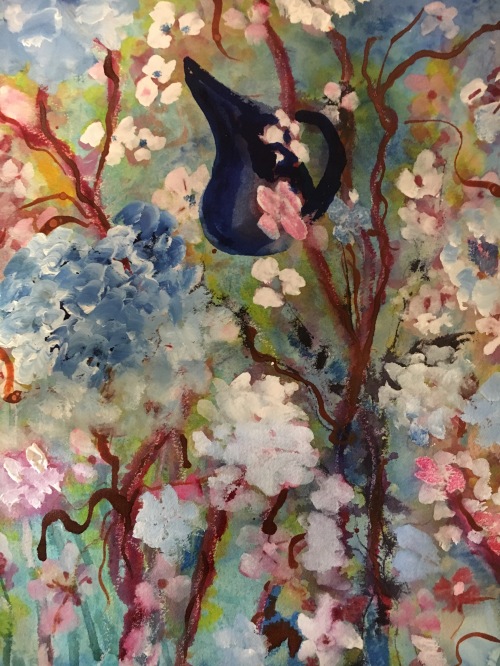
Glancing back over decades of freelance writing, I don’t recall ever experiencing that dreaded infirmity called “Writer’s Block”. Perhaps that is because, as I am doing at this moment, I always wrote from real life rather than fiction–although I love to read fiction at well as documentary and other forms of non-fiction.
The term “Writer’s Block” amuses me because my writing has always been a form of talking. I certainly have never suffered from “Talker’s Block”.
Art is different. Frequently I have a spell where I think I can never again produce anything “suitable for framing”. Many artists have similar periods when they struggle with doubts and a dearth of that nebulous thing called “inspiration”. My antidote for Artist’s Block is simply to plow right through it. There may be days of frustration over perceived failures, but I find comfort in keeping on and working through the block.
Oxymoronic as it may appear, my dual approach to the block is to: 1) try something totally new either in subject, materials, or methods and 2) try to bang out something that has worked before. Above is a sample of both options–a sailboat in trouble, an often rendered subject but this time in acrylics, still new and challenging to me.
Our family had many years of pleasant sailing on local inland lakes where falling in the warm water meant a fun swim and turtling the boat made for uproarious storytelling in retrospect. But one family sail was not so pleasant. In our cub boat we foolishly set out from a quiet cove which was sheltered from the elements, with the plan to explore one of the Apostle Islands in Lake Superior–the Great Lake which allegedly “never gives up her dead”. *
And if you know the Great Lake–at least the two that I’ve experienced, Lake Michigan and Lake Superior–you are very familiar with the adjective “COLD”!
Anyway, we left that quiet cove, out into the immense lake (I believe the second largest inland water in the world–the first largest being somewhere in Russia) and horrendous winds bombarded us seemingly from all directions. There were five of us in the boat–my husband, myself, our two teen-age sons Eric and Karl, and our lab/collie Duffy.
I praise God for my husband Joe’s Viking DNA. He miraculously sailed us back to land with the help of the boys. Duffy and I were ballast. We huddled in the bottom of the boat, praying–at least I was praying. I hung on to Duffy as hard as I could, and I think he was as terrified as I was.
So why in the world do I love to paint sailboats in trouble? More than reliving an experience, I think the reasons are motion and water, since both make for interesting visuals. Motion and water are easy for me to paint. And due to incorporating acrylic paints which are still stretching me, the above painting titled “On the Edge” (part of a series) proved to be a complete therapy.
Voila. Once again I’ve immerged from the block. Three happy starts of paintings were produced in my studio this very evening. The starts are happy enough that I decided to share my method of working through the block! 🙂
————————————————————-
*I knew the phrase about Lake Superior “never giving up her dead” came from Canadian troubadour Gordon Lightfoot’s classic ballad–“The Wreck of the Edmund Fitzgerald” which helped to immortalize that historic 1975 tragedy.
Also I wondered if the phrase had actually been a traditional saying, perhaps passed down through Native American cultures in the region.
GOOGLE only reinforced the fact that the saying came from Gordon Lightfoot’s ballad, and I can find no extra specific info. But the following Wikipedia quote indicates that Lake Superior’s reputation is well-founded since Superior is the largest of the Great Lakes:
“The Great Lakes, a collection of five freshwater lakes located in North America, have been sailed upon since at least the 17th century, and thousands of ships have been sunk while traversing them. Many of these ships were never found, so the exact number of shipwrecks in the Lakes is unknown; the Great Lakes Shipwreck Museum approximates 6,000 ships and 30,000 lives lost, while historian and mariner Mark Thompson has estimated that the total number of wrecks is likely more than 25,000.
“In the period between 1816, when the Invincible was lost, to the sinking of the Edmund Fitzgerald in 1975, the Whitefish Point area in Lake Superior alone has claimed at least 240 ships.”
Margaret L. Been — October, 2018


